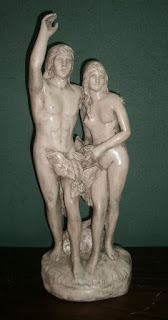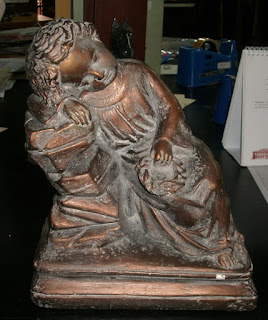“ MALAKAS AT
MAGANDA”
by ANASTACIO T. CAEDO. [1907 – 1990]
marble cast.
Sculpture:- 47cm high x 12cm wide.
Base:- 6cm deep x 18.5cm long x 15cm wide.
Signed:- A.T. CAEDO – 1955.
IMPORTANT NOTE.
This sculpture became the trophy of the Philippine Sports
Association.
The
title “ Malakas at Maganda” is
from
Philippine Folklore
Malakas and Maganda is about the origin of the native Filipinos.
“ When Bathala (God) was done creating the world, he was bored. He
looked down over the earth and sent a bird into the world. The bird
was flying around when it heard some sounds and tapping somewhere in
the forest. The bird landed and found out that the sound is coming
from a huge bamboo. He started pecking on it and pretty soon it split
in the middle where a man came out of it. His name was Malakas, which
means strong, and he told the bird, "My mate is in the other
piece of wood." They got her out and her name was Maganda which
means beautiful. The two got on the bird's back and flew away to find
some place to live. They went flying around the world, and then
finally, the bird saw a land and let the two giants set foot and live
on it. When Malakas and Maganda stepped on the land their weight
separated the land into islands (Philippines has 7,200 islands).
Malakas and Maganda live on and produced millions of children, which
came to be the Filipinos.” [from bamboo man.com]
DESCRIPTION OF
THE SCULPTURE
This sculpture of “Malakas at Maganda” is a very beautiful Caedo
sculpture that has the two naked figures standing together with the
male with his arm around the shoulders of the female.
Both
have long hair though the
female is much longer and falls down her back.
Maganda looks straight ahead and Malakas has his mouth open as if
addressing or calling someone, with his right arm raised in a gesture
to get someone’s attention.
Both of Magandas arms are to her right side where she is holding a
flower, which is clearly seen and the two fingers from her right
hand, she seems happy and unconcerned.
The
Sculptor has both Malakas and Maganda either
standing in front of or coming through
a large plant, the foliage
is displayed
behind and between the
both of them, it comes up above the left knee of Malakas and up the
right thigh of Maganda.
The
leaves and the fruit from the plant can be clearly seen and one large
leaf covers the front of
Malakas.
Maganda is uncovered.
They are standing bare footed on the base which seems to be a grassy
knoll.
From
the back of the sculpture the large
plant can be clearly seen
growing up from behind a rock.
Leaves from the plant are pressed up against both people.
The back torso of Malakas at Maganda are both uncovered.
DISTINGUISHING
MARKS
. Around the base of the sculpture, the Sculptor has carved lines
into the marble to indicate grass and it can be seen that the couple
are standing on a rise.
. There are no marks under the base of the sculpture.
. The signature is between the feet of Malakas and it reads :- A.
T. CAEDO
1955
. the second last toe on the left foot of Malakas, a chisel mark can
be seen across the top of the toe, not seen anywhere else.
Mark E Shellshear.
Art Consultant.
markshellshear@gmail.com































